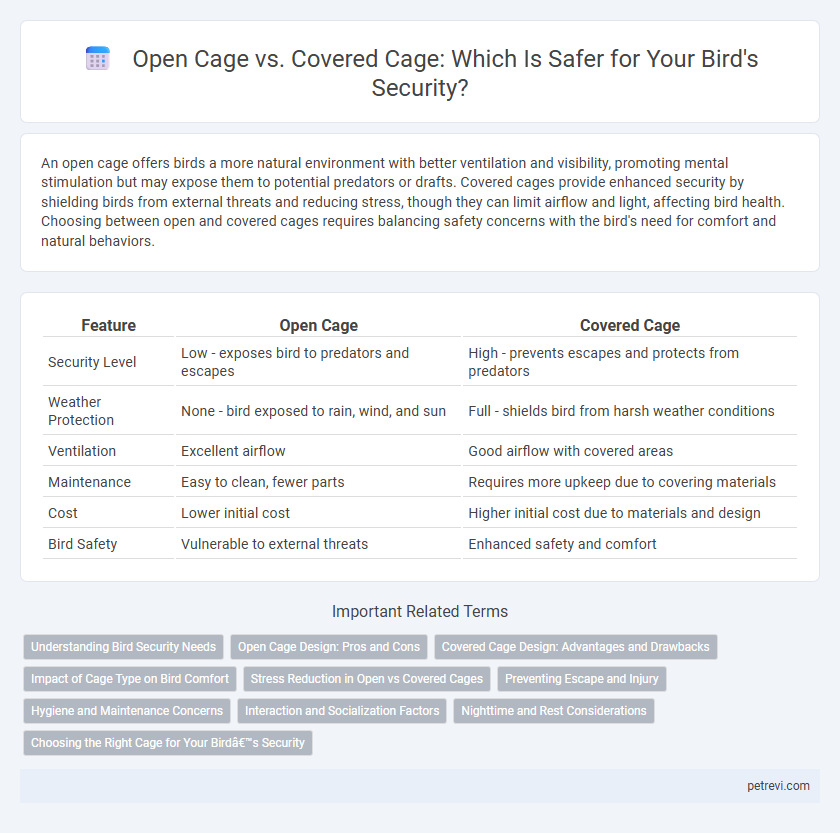An open cage offers birds a more natural environment with better ventilation and visibility, promoting mental stimulation but may expose them to potential predators or drafts. Covered cages provide enhanced security by shielding birds from external threats and reducing stress, though they can limit airflow and light, affecting bird health. Choosing between open and covered cages requires balancing safety concerns with the bird's need for comfort and natural behaviors.
Table of Comparison
| Feature | Open Cage | Covered Cage |
|---|---|---|
| Security Level | Low - exposes bird to predators and escapes | High - prevents escapes and protects from predators |
| Weather Protection | None - bird exposed to rain, wind, and sun | Full - shields bird from harsh weather conditions |
| Ventilation | Excellent airflow | Good airflow with covered areas |
| Maintenance | Easy to clean, fewer parts | Requires more upkeep due to covering materials |
| Cost | Lower initial cost | Higher initial cost due to materials and design |
| Bird Safety | Vulnerable to external threats | Enhanced safety and comfort |
Understanding Bird Security Needs
Open cages provide birds with ample ventilation and visibility but may expose them to predators and environmental hazards, compromising security. Covered cages offer enhanced protection by shielding birds from external threats and harsh weather, promoting a safer environment. Understanding bird species' natural behaviors and vulnerabilities helps determine the optimal cage type to meet their specific security needs.
Open Cage Design: Pros and Cons
Open cage design provides excellent ventilation and natural light for birds, promoting healthier respiratory and psychological well-being. However, it offers less protection against predators, environmental hazards, and bird escapes compared to covered cages. The choice depends on balancing freedom of movement and exposure risks in different environments.
Covered Cage Design: Advantages and Drawbacks
Covered cage designs for bird security offer enhanced protection against predators, harsh weather, and escape risks by providing a fully enclosed and durable structure. These designs improve bird comfort and safety by incorporating materials resistant to rust and damage, ensuring long-term use and minimal maintenance. However, limited ventilation and restricted natural sunlight can affect bird health, requiring careful planning to balance security with environmental needs.
Impact of Cage Type on Bird Comfort
Open cages provide superior ventilation and natural light, promoting better respiratory health and mental stimulation for birds. Covered cages offer a sense of security by mimicking natural shelters, reducing stress and encouraging restful sleep. Choosing the right cage balances airflow and privacy, directly impacting a bird's comfort and overall well-being.
Stress Reduction in Open vs Covered Cages
Open cages provide increased ventilation and natural light, which significantly reduce stress levels in birds by mimicking their natural environment. Covered cages can induce stress due to restricted airflow and limited visibility, preventing birds from feeling secure and causing anxiety. Studies show that birds in open cages exhibit calmer behavior and improved mental health compared to those housed in covered enclosures.
Preventing Escape and Injury
Open cages provide ample ventilation and visibility but increase the risk of bird escape and injury due to wider bar spacing. Covered cages offer enhanced security by restricting flight paths and reducing exposure to hazards, minimizing the chances of escape or harm. Selecting a covered cage with proper bar spacing and sturdy locks effectively prevents bird escape and injury while maintaining safety.
Hygiene and Maintenance Concerns
Open cages allow better airflow and easier cleaning, reducing the risk of bacterial growth and respiratory issues in birds. Covered cages can trap moisture and waste, leading to increased maintenance and potential hygiene problems if not cleaned regularly. Regular sanitation is crucial in both types to ensure a healthy living environment and prevent diseases such as avian psittacosis and aspergillosis.
Interaction and Socialization Factors
Open cages foster natural interaction and socialization among birds by providing ample space and visibility, encouraging communication and bonding. Covered cages limit exposure to external stimuli, reducing stress but potentially hindering social engagement and mental stimulation. Choosing between open and covered cages hinges on balancing security with opportunities for enrichment and social behavior.
Nighttime and Rest Considerations
Open cages provide better airflow and natural light exposure, promoting healthier sleep cycles for birds during nighttime. Covered cages offer enhanced protection from drafts and sudden temperature changes, crucial for maintaining bird security and comfort while resting. Choosing the right cage depends on balancing ventilation needs with environmental safety to ensure optimal nighttime rest and overall well-being.
Choosing the Right Cage for Your Bird’s Security
Open cages offer better ventilation and visibility, promoting natural bird behavior and reducing stress, but they may expose your bird to external threats. Covered cages provide enhanced security and protection from drafts, predators, and environmental hazards while creating a cozy resting space. Selecting the right cage entails balancing your bird's safety needs and comfort preferences, ensuring a secure environment tailored to the species' natural habits.
Open Cage vs Covered Cage for Bird Security Infographic

 petrevi.com
petrevi.com